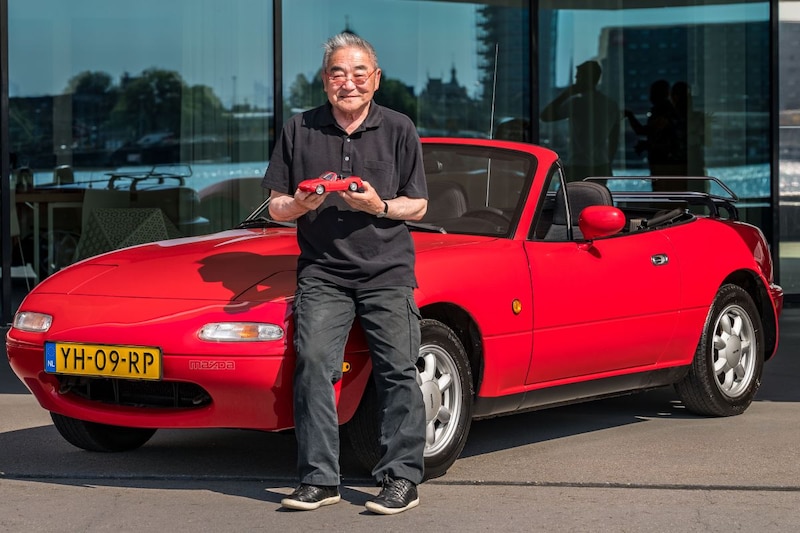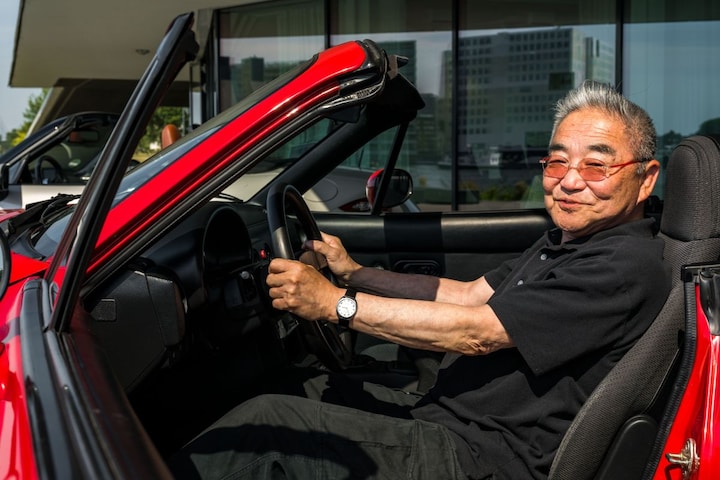Design car not reviewed by new sales

He once went to Los Angeles on spec to become a designer. He was promoted away to Australia, but came back and gave the world the iconic Mazda MX-5. We speak to Tom Matano and meet a colorful man.
He may not be as well known as Adrian van Hooydonk, Peter Schreyer or Luc Donckerwolke, but Tom Matano certainly deserves that fame. The little sympathetic Japanese has a resume to say the least, with the absolute highlight being the best-selling roadster of all time. Indeed, Matano-san was the founder of the Mazda MX-5. As a great fan of that model and owner of a second-generation MX-5, I go to our lunch appointment in the Eye in Amsterdam with extra high expectations. Matano has had his own design studio in San Francisco, Matano Design, since 2003, but during our conversation it soon becomes clear that his quarter century at Mazda has impressed him the most.

Matano-san was the founder of the Mazda MX-5.
After completing his engineering studies in Tokyo, Tom Matano got off a plane in Los Angeles in 1970 with little more than his suitcase and lofty ambitions to make it into the automotive design world. “I was only there a few days when I realized you couldn’t live without a car in Los Angeles,” he says. His choice was remarkable considering which icon he later drew. Young Matano was soon driving through California in a Fiat 128 Spider. For the next four years, he studied Transport Design at the Art Center College of Design in Los Angeles, which earned him an admission ticket to General Motors. He signed in the Oldsmobile Studio on the 1976 Cutlass Coupe 442, the 1977 Oldsmobile 98, the 1978 Omega and the 1978 Toronado. However, the energy crisis and subsequent layoffs at GM put an end to his flying start. Matano was promoted away to the Australian branch, Holden, with the promising words: ‘When the economy picks up, we’ll call you again.’ “That never happened,” Matano says with a laugh. “I stayed in Australia for six years but wanted to focus on aerodynamics. Australia didn’t have a single wind tunnel at the time,” says the Japanese. So Matano left for Europe, where he was allowed to work at BMW on the streamlining of the future E36. “The E30 had just been introduced at the time, we were working well ahead,” says Matano. “The development of a model then took about ten years.”

Mazda MX-5 in the NA.
Matano has not forgotten his roots and we see him in 1983 in Mazda’s California design studio. “Mazda already had several design teams around the world back then, all working on the same projects. That may seem like a competition, but it was not a matter of winning or losing, but choosing the right design,” he says. In any case, the Miata was such a correct design, we now know.
Global designs much more difficult
In those years, car models became more and more global, something Matano was particularly involved in, he says. “Global design is more difficult than you think. It is often in the craziest details, also technically. I remember a plastic case we wrapped around a wiring harness to protect it from being exposed to the sea air during shipping to the United States. Later we started producing that model in America, but nobody realized that we could have cut that part. Also consider the gear ratios of the transmissions. In America the corners are much wider than in Japan. If you don’t adjust the box to that, an American driver will get into trouble.”
Asian men urinate more often than Americans
Especially in the design, Matano encountered crazy differences, with at least as crazy solutions. “In the US, people drive a lot of long distances and then you want to interrupt your ride as little as possible,” he says. “Then it is important to adjust the tank content somewhat to the interval of an average bathroom break. I had the impression that Asian men have to pee more often than Americans and I put it to the test during an intercontinental flight in business class. I asked the flight attendant to keep an eye on how often my fellow passengers went to the toilet and to my surprise she took it very seriously so that upon arrival I was given a detailed list of each passenger’s bathroom breaks. But my suspicion was correct.”
Matano also learned through trial and error. “We initially replaced the ashtray with a cup holder for the US market, but this often caused the contents to tip over the car radio, resulting in all kinds of claims for damages.”
Creative Limitations on World Cars
Designing world cars also has its creative limitations, Matano believes. “As a relatively small player, Mazda has a lot of freedom in that regard,” he says. “For the opposite, just look at Toyota. That’s so big that it always sets the pace, whether you like it or not. It forces its models on the world, improves them over the run time and in the end they look more or less okay. That brand has the power to do that.”

The NA between two Mazda MX-5 generation ND.
So limitless design, but does it also have to be timeless? “That’s an interesting issue,” says Matano. “Good design is not so much judged by the new sales of the car, but by how well it can be worn second-hand ten years later. A strong example of this, I can already predict that, will be the current BMW 4-series. That front is so massive that the rest of the car behind it disappears. I’m already telling you that you won’t be able to sell it in ten years.”
.
– Thanks for information from Autoweek.nl